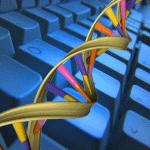Bioinformatics
|
19 august 2014 06:04:31 |
| pH Dependence of Conformational Fluctuations of the Protein Backbone (Proteins: Structure, Function, and Bioinformatics) |
|
Tweet Proton binding equilibria (pKa values) of ionizable groups in proteins are exquisitely sensitive to their microenvironments. Apparent pKa values measured for individual ionizable residues with NMR spectroscopy are actually population-weighted averages of the pKa in different conformational microstates. NMR spectroscopy experiments with staphylococcal nuclease were used to test the hypothesis that pKa values of surface Glu and Asp residues are affected by pH-sensitive fluctuations of the backbone between folded and locally unfolded conformations. 15N spin relaxation studies showed that as the pH decreases from the neutral into the acidic range the amplitudes of backbone fluctuations in the ps-ns timescale increase near carboxylic residues. Hydrogen exchange experiments suggested that backbone conformational fluctuations promoted by decreasing pH also reflect slower local or sub-global unfolding near carboxylic groups. This study has implications for structure-based pKa calculations: (1) The timescale of the backbone`s response to ionization events in proteins can range from ps to ms, and even longer; (2) pH-sensitive fluctuations of the backbone can be localized to both the segment the ionizable residue is attached to or the one that occludes the ionizable group; (3) Structural perturbations are not necessarily propagated through Coulomb interactions; instead, local fluctuations appear to be coupled through the cooperativity inherent to elements of secondary structure and to networks of hydrogen bonds. These results are consistent with the idea that local conformational fluctuations and stabilities are important determinants of apparent pKa values of ionizable residues in proteins. © Proteins 2014;. © 2014 Wiley Periodicals, Inc. |
| 161 viewsCategory: Biochemistry, Bioinformatics |
 Dual effects of familial Alzheimer`s disease mutations (D7H, D7N, and H6R) on amyloid ? peptide: Correlation dynamics and zinc binding (Proteins: Structure, Function, and Bioinformatics) Dual effects of familial Alzheimer`s disease mutations (D7H, D7N, and H6R) on amyloid ? peptide: Correlation dynamics and zinc binding (Proteins: Structure, Function, and Bioinformatics)Effective discrimination between biologically relevant contacts and crystal packing contacts using new determinants (Proteins: Structure, Function, and Bioinformatics) 
|
| blog comments powered by Disqus |
MyJournals.org
The latest issues of all your favorite science journals on one page
The latest issues of all your favorite science journals on one page



